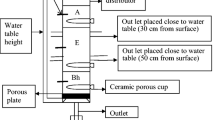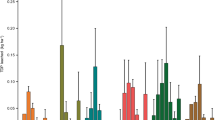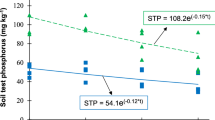Abstract
Consumer demand for cleaned squid generates a substantial amount of waste that must be properly disposed of, creating an economic burden on processors. A potential solution to this problem involves converting squid by-products into an organic fertilizer, for which there is growing demand. Because fertilizer application to lawns can increase the risk of nutrient contamination of groundwater, we quantified leaching of NO3–N and PO4–P from perennial ryegrass turf (Lolium perenne L.) amended with two types of fertilizer: squid-based (SQ) and synthetic (SY). Field plots were established on an Enfield silt loam, and liquid (L) and granular (G) fertilizer formulations of squid and synthetic fertilizers were applied at 0, 48, 146, and 292 kg N ha−1 year−1. Levels of NO3–N and PO4–P in soil pore water from a depth of 60 cm were determined periodically during the growing season in 2008 and 2009. Pore water NO3–N levels were not significantly different among fertilizer type or formulation within an application rate throughout the course of the study. The concentration of NO3–N remained below the maximum contaminant level (MCL) of 10 mg L−1 until midSeptember 2009, when values above the MCL were observed for SQG at all application rates, and for SYL at the high application rate. Annual mass losses of NO3–N were below the estimated inputs (10 kg N ha−1 year−1) from atmospheric deposition except for the SQG and SYL treatments applied at 292 kg N ha−1 year−1, which had losses of 13.2 and 14.9 kg N ha−1 year−1, respectively. Pore water PO4–P levels ranged from 0 to 1.5 mg P L−1 and were not significantly different among fertilizer type or formulation within an application rate. Our results indicate that N and P losses from turf amended with squid-based fertilizer do not differ from those amended with synthetic fertilizers or unfertilized turf. Although organic in nature, squid-based fertilizer does not appear to be more—or less—environmentally benign than synthetic fertilizers.



Similar content being viewed by others
References
Amador, J. A., Hull, R. J., Patenaude, E. L., Bushoven, J. T., & Gorres, J. H. (2007). Potential nitrate leaching under common landscaping plants. Water, Air, and Soil Pollution, 185, 323–333.
Booze-Daniels, J. N., & Schmidt, R. E. (1997). The use of slow release nitrogen fertilizers on the roadside—A literature review. Charlottesville: Department of Transportation.
Boyer, E. W., Goodale, C. L., Jaworski, N. A., & Howarth, R. W. (2002). Anthropogenic nitrogen sources and relationships to riverine nitrogen export in the northeastern U.S.A. Biogeochemistry, 57(58), 137–169.
Bushoven, J. T., Jiang, Z., Ford, H. J., Sawyer, C. D., Hull, R. J., & Amador, J. A. (2000). Stabilization of soil nitrate by reseeding with perennial ryegrass following sudden turf death. Journal of Environmental Quality, 29, 1657–1661.
Carpenter, S. R., Caraco, N. F., Correll, D. L., Howarth, R. W., & Sharpley, A. N. (1998). Nonpoint pollution of surface waters with phosphorus and nitrogen. Ecological Applications, 8, 559–568.
Christians, N. E. (1996). Phosphorus nutrition of turfgrass. Golf Course Management, 64, 54–57.
Doane, T. A., & Horwath, W. R. (2003). Spectrophotometric determination of nitrate with a single reagent. Analytical Letters, 36, 2713–2722.
Easton, Z. M., & Petrovic, A. M. (2004). Fertilizer source effect on ground and surface water quality in drainage from turfgrass. Journal of Environmental Quality, 33, 645–655.
Environmental Protection Agency. (1999). Background report on fertilizer use, contaminants and regulations. EPA 747-R_98-003. Washington: US Govt. Print. Office.
Exner, M. E., Burbach, M. E., Watts, D. G., Shearman, R. C., & Spalding, R. F. (1991). Deep nitrate movement in the unsaturated zone of a simulated urban lawn. Journal of Environmental Quality, 20, 658–662.
Frank, K. W., O’Reilly, K. M., Crum, J. R., & Calhoun, R. N. (2005). The fate of nitrogen applied to a mature Kentucky bluegrass turf. Crop Science, 46, 209–215.
Freedonia Group, Inc. (2008). Lawn and garden consumables report (p. 313). Freedonia Group, Inc: Cleveland.
Geron, C. A., Danneberger, T. K., Traina, S. J., Logan, T. J., & Street, J. R. (1993). The effects of establishment methods and fertilization practices on nitrate leaching from turfgrass. Journal of Environmental Quality, 22, 119–125.
Gold, A. J., De Ragon, W. R., Sullivan, W. M., & Lemunyon, J. L. (1990). Nitrate–nitrogen losses to groundwater from rural and suburban land uses. Journal of Soil and Water Conservation, 45, 305–310.
Gross, C. M., Angle, J. S., & Welterlen, M. S. (1990). Nutrient and sediment losses from turfgrass. Journal of Environmental Quality, 19, 663–668.
Guillard, K., & Kopp, K. L. (2004). Nitrogen fertilizer form and associated nitrate leaching from cool-season lawn turf. Journal of Environmental Quality, 33, 1822–1827.
Hallberg, G. R. (1989). Nitrate in ground water in the United States. In R. F. Follett (Ed.), Nitrogen management and ground water protection (pp. 35–74). Amsterdam: Elsevier.
Hummel, N. W., Jr. (1989). Resin-coated urea evaluation for turfgrass fertilization. Agronomy Journal, 81, 290–294.
Jiang, Z., Bushoven, J. T., Ford, H. J., Sawyer, C. D., Amador, J. A., & Hull, R. J. (2000). Mobility of soil nitrogen and microbial responses following the sudden death of established turf. Journal of Environmental Quality, 29, 1625–1631.
Lian, P. Z., Lee, C. M., & Park, E. (2005). Characterization of squid-processing byproduct hydrolysate and its potential as aquaculture feed ingredient. Journal of Agriculture and Food Chemistry, 53, 5587–5592.
Liu, H., Hull, R. J., & Duff, D. T. (1997). Comparing cultivars of three cool-season turfgrass for soil water NO3 concentration and leaching potential. Crop Science, 37, 526–534.
Mangiafico, S. S., & Guillard, K. (2006). Fall fertilization timing effects on nitrate leaching and turfgrass color and growth. Journal of Environmental Quality, 35, 163–171.
McCasland, M., Trautmann, N. M., Porter, K. S., & Wagenet, R. J. (1985). Nitrate: Health effects in drinking water [Online] http://pmep.cce.cornell.edu/facts-slides-self/facts/nit-heef-grw85.html. (Verified March 2010).
Miltner, E. D., Branham, B. E., Paul, E. A., & Rieke, P. E. (1996). Leaching and mass balance of 15 N-labeled urea applied to a Kentucky bluegrass turf. Crop Science, 36, 1427–1433.
Morton, T. G., Gold, A. J., & Sullivan, W. M. (1988). Influence of overwatering and fertilization on nitrogen losses from home lawns. Journal of Environmental Quality, 17, 124–129.
Munster, J. E. (2008). Nonpoint sources of nitrate and perchlorate in urban land use to groundwater. Ph.D. Dissertation, Stony Brook University, Stony Brook, NY, 132 pages.
Nardi, S., Morari, F., Berti, A., Tosoni, M., & Giardini, L. (2004). Soil organic matter properties after 40 years of different use of organic and mineral fertilisers. European Journal of Agronomy, 21, 357–367.
Nelson, K. E., Turgeon, A. J., & Street, J. R. (1980). Thatch influence on mobility and transformation of nitrogen carriers applied to turf. Agronomy Journal, 72, 487–492.
Petrovic, A. M. (1990). The fate of nitrogenous fertilizers applied to turfgrass. Journal of Environmental Quality, 19, 1–14.
Petrovic, A. M. (2008). Report to the Pleasant Bay Alliance on the turfgrass fertilizer nitrogen leaching rate. Available online at http://www.chatham-ma.gov/public_documents/ChathamMa_CWMPlan/Petrovicfinalreport.pdf (verified 13 April 2011).
Pye, V. I., & Patrick, R. (1983). Ground water contamination in the United States. Science, 221, 713–718.
Raviv, M. (2010). Sustainability of organic horticulture. Horticultural Reviews, 36, 289–334.
Saxton, K. E., Rawls, W. J., Romberger, J. S., & Papendick, R. I. (1986). Estimating generalized soil–water characteristics from texture. Soil Science Society of America Journal, 50, 1031–1036.
Sharpley, A. N., Daniel, T., Simms, T., Lemunyon, J., Stevens, R., & Parry, R. (2003). Agricultural phosphorus and eutrophication (2nd ed.). Washington: United States Department of Agriculture.
Sims, J. T., Simard, R. R., & Joern, B. C. (1998). Phosphorus loss in agricultural drainage: Historical perspective and current research. Journal of Environmental Quality, 27, 277–293.
Smith, V. H. 1996. Environmental indicators of water quality in the United States. EPA 841-R-96-002. USEPA, Office of Water , Washington, D.C., USA: U.S. Govt. Print. Office.
Snyder, G. H., Augustin, B. J., & Davidson, J. M. (1984). Moisture sensor-controlled irrigation for reducing N leaching in bermudagrass turf. Agronomy Journal, 76, 964–969.
Soil Survey Staff. (1981). Soil survey of Rhode Island. USDA-Soil Conservation Service. Washington: US Govt. Print. Office.
Soldat, D. J., & Petrovic, A. M. (2008). The fate and transport of phosphorus in turfgrass ecosystems. Crop Science, 48, 2051–2065.
Starr, J. L., & DeRoo, H. C. (1981). The fate of nitrogen fertilizer applied to turfgrass. Crop Science, 21, 531–536.
Walker, K. S., Bigelow, C. A., Smith, D. R., Van Scoyoc, G. E., & Reicher, Z. J. (2007). Aboveground responses of cool-season lawn species to nitrogen rates and application timings. Crop Science, 47, 1225–1236.
Acknowledgements
We are grateful for the assistance of the Turf Farm staff, particularly Gregory Fales, for support and cooperation with field experiments, and to Janet Atoyan for technical help. Provision of financial assistance to J.C.F. by the University of Rhode Island Turfgrass Foundation is gratefully acknowledged. This study was funded in part by a grant from the Rhode Island SeaGrant College Program (Project No. R/OF-0810-2-53) and by the Rhode Island Agricultural Experiment Station (Contribution # 5274).
Author information
Authors and Affiliations
Corresponding author
Rights and permissions
About this article
Cite this article
Fetter, J.C., Brown, R.N., Görres, J.H. et al. Nitrate and Phosphate Leaching under Turfgrass Fertilized with a Squid-based Organic Fertilizer. Water Air Soil Pollut 223, 1531–1541 (2012). https://doi.org/10.1007/s11270-011-0962-y
Received:
Accepted:
Published:
Issue Date:
DOI: https://doi.org/10.1007/s11270-011-0962-y




